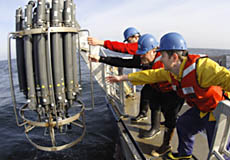Disclaimer: These postings were sent to us from a variety of media sources over the Internet. The content has not been reviewed for scientific accuracy or edited in any manner.
Red tide shuts island beds
Opportunities to buy and sell shellfish in Massachusetts have now narrowed to just a few ports. Hard on the heels of the closure Thursday of one of the state's most productive areas, Monomoy Island and an adjacent area known as the Southway, the state Division of Marine Fisheries yesterday closed the rest of Chatham and all of Nantucket.
 | Larry Anderson, right, Bruce Keafer, center, WHOI research associates and Mike Brosnahan, a graduate student, conduct tests aboard the research vessel Tioga yesterday. (Staff photo by KEVIN MINGORA) |
The toxin concentrations found in blue mussels in the Nantucket Harbor inlet was 333 micrograms per 100 grams of shellfish meat, four times the legal limit. DMF chief shellfish biologist Michael Hickey said the contamination happened overnight since Nantucket shellfish showed no algae toxins in tests Thursday.
Woods Hole Oceanographic Institution research biologist Bruce Keafer said he knew that was coming yesterday. He, and a boat full of red tide detectives raced down the coast from the mouth of the Merrimack River in Newburyport, across Massachusetts Bay, along the Outer Cape and through Nantucket Sound. What they found was a highway of red tide cells, at points more than 30 miles wide, pushed south by a freshwater current, with Nantucket right in the cross hairs. Keafer's group found red tide cells had also pushed deep into Nantucket Sound, at possible toxic amounts all as far as a point off Hyannis.
The WHOI research vessel Tioga pitched, rolled and surged forward at a top cruising speed of 20 knots. The vessel was trying to cover as much ground as possible in 12 hours, sampling water for red tide cells, mostly on the fly. Keafer put his eyes close to the microscope, careful not to get too close lest a sudden movement of the boat send the eyepiece of the microscope lurching his way.
''They're here,'' he said.
A cluster of Alexandrium algae, backlit by the microscope light, glowed yellow and green. Shaped like a basketball with an almost invisible whiplike tail propelling it, the Alexandrium, aka red tide, produce a powerful toxin that can paralyze and even kill a human being when the poison becomes concentrated in the meats of shellfish. With the biggest red tide outbreak ever on the Cape's doorstep, researchers like Keafer are hoping to find answers to how better to forecast when and where major outbreaks will happen and how toxic they will be. They are also on the front lines in aiding a beleaguered state DMF which must make sure that areas still open are safe while in the path of one of a fast moving, toxic algal bloom.
Scientists on the Tioga yesterday were each holding a piece of the puzzle as to why this bloom has spread so far and fast. WHOI scientist Ruoying He was attempting to develop a computer model that would show how this bloom and future blooms are spread by ocean currents and surface winds. Graduate student Michael Brosnahan was looking at finding genetic signatures that would tell which offshore area individual strains of Alexandrium came from. And Keafer said he hoped that knowledge of what makes a bloom happen would lead to offshore automated observatories that could sample water and warn state shellfish authorities when a bloom was headed their way.
The Tioga is a floating laboratory. At pre-determined points, scientists drop a large circular arrangement of tubes known as a CTD into the water. The five-foot high tubes sample water at 1, 10 and 20 meters, also checking for conductivity (which reveals the salinity of the water, the temperature and the depth). The tubes also capture microscopic life, like the phytoplankton, of which the Alexandrium cells are one component.
In the lab below decks, scientists and volunteers ignore the tossing of their lab and the seasickness that inevitably claims some, to perform delicate measurement and preservation tasks that will help give a better picture of the current bloom and help in forecasting future outbreaks.
The air temperature offshore yesterday was a chilly 48 degrees, as cold as the water which was also around 48 degrees. Cold for us, but perfect for Alexandrium cells which flourish in water temperatures from the mid-40s to the mid-50s. Even more ominous were the salinity readings which ran about the same as a river mouth emptying into the ocean.
Keafer explained that the Alexandrium cells like the inshore mix of fresh and salt water because the fresh water is lighter and floats on top in a layer that traps the algae in a layer where they can draw energy from the sun. Getting freshwater readings off the Outer Cape could also mean that the red tide could still be riding the nutrient-rich river water from Maine where the original outbreak started early last month. Freshwater could also have come from Massachusetts rivers like the Merrimack and Charles and the Boston Outfall Pipe. High cell counts combined with what appears to be a plentiful freshwater supply, could mean the outbreak could last into July, Keafer said yesterday.
Shellfishing areas are now closed from Down East Maine to Nantucket.
As the bloom appears to show few signs of waning, states to the south are now starting to worry.
''New York is obviously very interested in what's going on up here, everybody is when these things start. Rhode Island is concerned and they're staying in touch,'' Hickey said.
(Published: June 4, 2005)